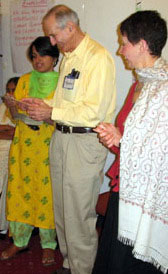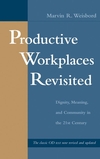 This is the sequel to Productive Workplaces (1987), voted by the OD Network one of the influential OD books of the last 40 years. This 2004 edition includes nearly all of the earlier work plus 100 new pages. In it, I report on what happened to organizations 15 to 30 years after major efforts to institutionalize changes for the better. If you are interested in the “sustainability” of OD projects, here’s what I learned from the 10 cases I followed up years later:
This is the sequel to Productive Workplaces (1987), voted by the OD Network one of the influential OD books of the last 40 years. This 2004 edition includes nearly all of the earlier work plus 100 new pages. In it, I report on what happened to organizations 15 to 30 years after major efforts to institutionalize changes for the better. If you are interested in the “sustainability” of OD projects, here’s what I learned from the 10 cases I followed up years later:
–Four organizations no longer existed.
–Four more were owned by other companies.
–Only two had the same owner in 2004 (and only one by 2005).
–With one exception I had a hard time connecting any current practices with my old OD work. In most cases few people were left who remembered.
–I asked any leaders I could find with whom I worked 15 to 30 years earlier if they would do their OD projects again. All to my surprise said “yes.” You can find out why in Chapter 22.
Some conclusions: “Sustainable change” is an oxymoron. We build organizational cultures for today only, not for the ages. What I have learned about learning organizations is that every generation needs to learn all over again for itself. Therefore, you have to make today’s meeting an example of the future you desire. Seize the day, and do your best. The future, friends, never comes. It’s already here. But you knew that already!
Download an Excerpt from the Introduction to Productive Workplaces Revisited.
If you buy the book through this web site, you also support the worldwide community services of Future Search Network.

Productive Workplaces Revisited: Dignity,
Meaning, and Community in the 21st Century
Marvin R. Weisbord
ISBN: 0-7879-7117-0
Hardcover
544 pages
February 2004, Jossey-Bass/Wiley
US $46.00
Table of Contents
(* Indicates new chapters or updates for this edition)
Acknowledgments
About the Author
*Introduction: How to Get the Most from Productive Workplaces Revisited
*1. A Personal Prologue: Discovering Theories X and Y
Part One: The Search for Productive Workplaces
*2. Scientific Management Revisited: A Tale of Two Taylors
*3. The Consulting Engineer: Taylor Invents a New Profession
*4. Lewin: The Practical Theorist
*5. The Learning Organization: Lewin’s Legacy to Management
*6. McGregor and the Roots of Organization Development
*7. The Human Side of Enterprise Revisited: A New Look at Theories X and Y
*8. Undoing Taylorism: Emery, Trist, and the Sociotechnical Revolution
*9. Open Systems and the New Paradigm: How Emery and Trist Redefined the Workplace
Part Two: Transforming Theory into Practice and Practice into Theory
*10. Adding Action to Research: Lewin’s Practice Theory Road Map
*11. Methods of Diagnosis and Action: Taking Snapshots and Making Movies
*12. Rethinking Organizational Improvement: New Perspectives on Consultation
*13. Improving Whole Systems: Alternatives to the Report-in-the-Drawer Phenomenon
*14. Management Training in Academic Medicine
*15. Productivity After Taylor: Systems Learning Replaces Expert Analysis
Part Three: Learning and Applying New Practice Theories
*16. Managing and Consulting in the 21st Century
*17. Transforming Teamwork: Working Relationships in a Fast-Changing World
*18. Designing Work: Structure and Process for Learning and Self-Control
*19. Managing and Consulting Beyond the Design Limits: Changing Everything at Once
*20. Future Search: Evolving a Whole Systems Improvement Strategy.
*21. Improving Whole Systems Worldwide
*22. How There and Then Looks from Here and Now: Ten Cases Revisited
*Epilogue: Still Caught Between Paradigms: Where Do We Go from Here?
Quotes from the INTRODUCTION…
“During a decade of teaching future search to people around the world, I heard a theme repeated time and again. How can anybody be sure the plans people make are actually carried out? How can we build in enduring, constructive norms and processes?
“I have pondered that question for many years. I doubt that anybody can “build in” a technical insurance policy for ongoing success that trumps people’s willingness to keep revisiting worthy goals and to stay connected with each other. The key leadership policy I advocate is involving those who do the work in planning the work. The best methods for doing that tend to be simple.
“Why then lust after high-performing work systems through increasingly complicated programs? As I pondered that question, I began wondering what had happened to the organizations whose case studies form the core of this book. For nearly 30 years I had been involved in strategic reorganizations intended to create and maintain productive workplaces.
“What happened afterwards? What could I learn about turbulence, transformation, stability, follow-up and continuity by seeking out clients I’d known years back and tracing the lives of organizations I once had sought to make more productive? With 20/20 hindsight and 15 to 30 years of emotional distance could I discern patterns now that weren’t apparent then? Productive Workplaces Revisited is the result. This work contains nearly all the text of the first edition plus 100 pages of new material.”
Advice on Techniques…
I believe that “getting everybody improving whole systems” remains a worthwhile and elusive purpose if you care about worthy workplaces. Embedded in this prescription are values of ongoing inquiry and widening inclusion. The hard part, in a world of infinite choices, is finding techniques equal to our values.”
“You can sail this sea of possibility to uncharted new worlds. You also can drown in it. I can tell you with the confidence born of 40 years of chasing rainbows to the far horizon that you will not be able to absorb, let alone use, the proliferating workplace change library. Let go the attractive myth that you will one day learn to choose from the myriad exactly the right process each time.”